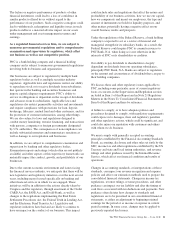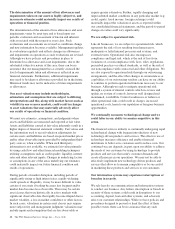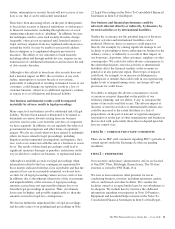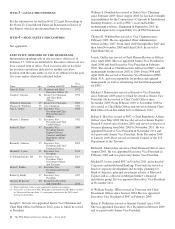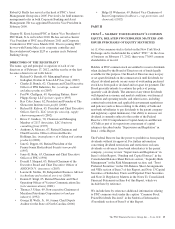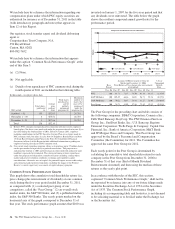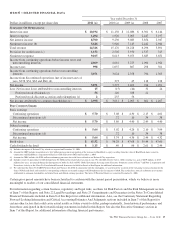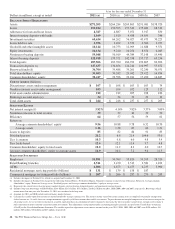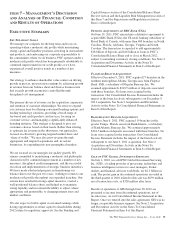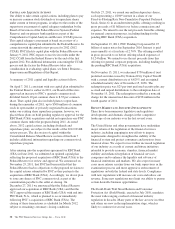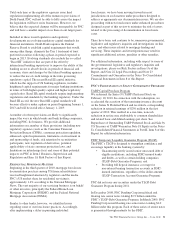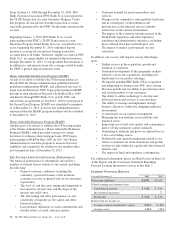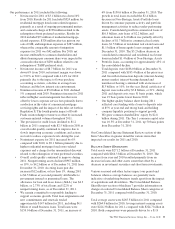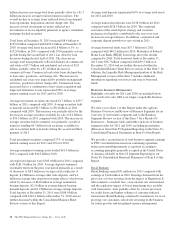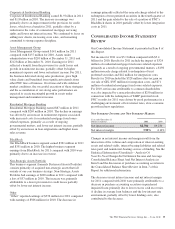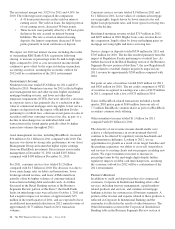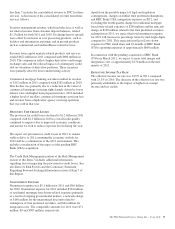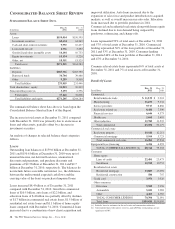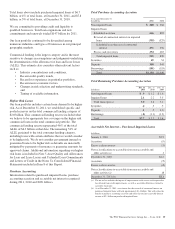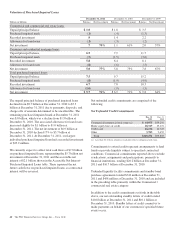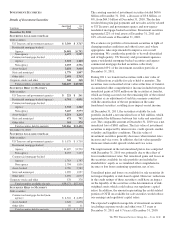PNC Bank 2011 Annual Report Download - page 40
Download and view the complete annual report
Please find page 40 of the 2011 PNC Bank annual report below. You can navigate through the pages in the report by either clicking on the pages listed below, or by using the keyword search tool below to find specific information within the annual report.
Until such time as the regulatory agencies issue final
regulations implementing all of the numerous provisions of
Dodd-Frank, PNC will not be able to fully assess the impact
the legislation will have on its businesses. However, we
believe that the expected changes will be manageable for PNC
and will have a smaller impact on us than on our larger peers.
Included in these recent legislative and regulatory
developments are evolving regulatory capital standards for
financial institutions. Dodd-Frank requires the Federal
Reserve Board to establish capital requirements that would,
among other things, eliminate the Tier 1 treatment of trust
preferred securities following a phase-in period expected to
begin in 2013. Evolving standards also include the so-called
“Basel III” initiatives that are part of the effort by
international banking supervisors to improve the ability of the
banking sector to absorb shocks in periods of financial and
economic stress and changes by the federal banking agencies
to reduce the use of credit ratings in the rules governing
regulatory capital. The recent Basel III capital initiative,
which has the support of US banking regulators, includes
heightened capital requirements for major banking institutions
in terms of both higher quality capital and higher regulatory
capital ratios. Basel III capital standards require implementing
regulations and standards by the banking regulators. Under the
Basel III accord, the new Basel III capital standards will
become effective under a phase-in period beginning January 1,
2013 and will be in full effect January 1, 2019.
A number of reform provisions are likely to significantly
impact the ways in which banks and bank holding companies,
including PNC, do business. We provide additional
information on a number of these provisions (including new
regulatory agencies (such as the Consumer Financial
Protection Bureau (CFPB)), consumer protection regulation,
enhanced capital requirements, limitations on investment in
and sponsorship of funds, risk retention by securitization
participants, new regulation of derivatives, potential
applicability of state consumer protection laws, and
limitations on interchange fees) and some of their potential
impacts on PNC in Item 1 Business–Supervision and
Regulation and Item 1A Risk Factors of this Report.
R
ESIDENTIAL
M
ORTGAGE
M
ATTERS
Beginning in the third quarter of 2010, mortgage foreclosure
documentation practices among US financial institutions
received heightened attention by regulators and the media.
PNC’s US market share for residential servicing is
approximately 1.4% according to the National Mortgage
News. The vast majority of our servicing business is on behalf
of other investors, principally the Federal Home Loan
Mortgage Corporation (FHLMC) and the Federal National
Mortgage Association (FNMA).
Similar to other banks, however, we identified issues
regarding some of our foreclosure practices. Accordingly,
after implementing a delay in pursuing individual
foreclosures, we have been moving forward in most
jurisdictions on such matters under procedures designed to
address as appropriate any documentation issues. We are also
proceeding with new foreclosures under enhanced procedures
designed as part of this review to minimize the risk of errors
related to the processing of documentation in foreclosure
cases.
There have been, and continue to be, numerous governmental,
legislative and regulatory inquiries and investigations on this
topic and other issues related to mortgage lending and
servicing. These inquiries and investigations may result in
significant additional actions, penalties or other remedies.
For additional information, including with respect to some of
the governmental, legislative and regulatory inquiries and
investigations, please see Risk Factors in Item 1A of this
Report, and Note 22 Legal Proceedings and Note 23
Commitments and Guarantees in the Notes To Consolidated
Financial Statements in Item 8 of this Report.
PNC’
S
P
ARTICIPATION IN
S
ELECT
G
OVERNMENT
P
ROGRAMS
TARP Capital Purchase Program
We redeemed the Series N (TARP) Preferred Stock on
February 10, 2010. In connection with the redemption, we
accelerated the accretion of the remaining issuance discount
on the Series N Preferred Stock and recorded a corresponding
reduction in retained earnings of $250 million in the first
quarter of 2010. This resulted in a one-time, noncash
reduction in net income attributable to common shareholders
and related basic and diluted earnings per share. See
Repurchase of Outstanding TARP Preferred Stock and Sale by
US Treasury of TARP Warrant in Note 18 Equity in the Notes
To Consolidated Financial Statements in Part II, Item 8 of this
Report for additional information.
FDIC Temporary Liquidity Guarantee Program (TLGP)
The FDIC’s TLGP is designed to strengthen confidence and
encourage liquidity in the banking system by:
• Guaranteeing newly issued senior unsecured debt of
eligible institutions, including FDIC-insured banks
and thrifts, as well as certain holding companies
(TLGP-Debt Guarantee Program), and
• Providing full deposit insurance coverage for
non-interest bearing transaction accounts in FDIC-
insured institutions, regardless of the dollar amount
(TLGP-Transaction Account Guarantee Program).
PNC did not issue any securities under the TLGP-Debt
Guarantee Program during 2011.
In December 2008, PNC Funding Corp issued fixed and
floating rate senior notes totaling $2.9 billion under the
FDIC’s TLGP-Debt Guarantee Program. In March 2009, PNC
Funding Corp issued floating rate senior notes totaling $1.0
billion under this program. Each of these series of senior notes
is guaranteed through maturity by the FDIC.
The PNC Financial Services Group, Inc. – Form 10-K 31


